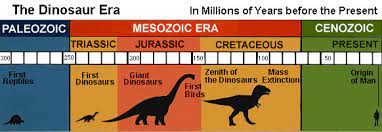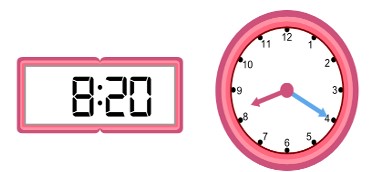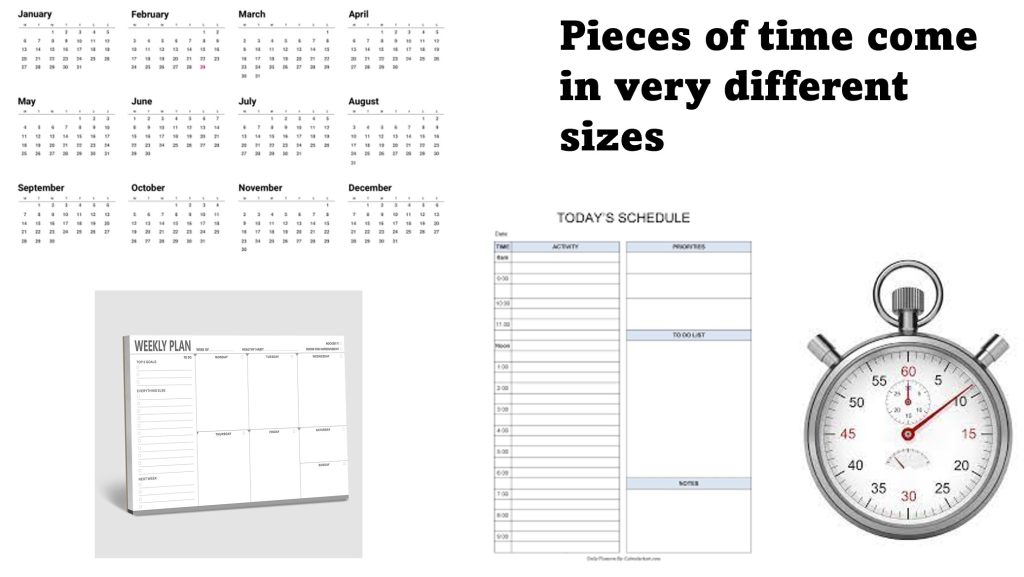9 Organizing Time and Organizing with Time
Organizing time is an essential skill and activity, but it is a bit tricky compared with other kinds of organizing. That’s because there are two very different ways of thinking about time.
- Time is a RESOURCE when you say things like “I don’t have enough time to do that” or “We have lots of time so we don’t have to hurry.”
- Time is an ORGANIZING PRINCIPLE when you arrange people by their ages to put them on sports teams, or when you list the presidents in order starting with George Washington. People, events, or other resources usually have one or more “time stamps” of some kind as properties — a birthday, the day they happened, the day they were acquired.
1. Time is a resource that we organize so that we can play, work, study, or do any other activity
Earlier in this book you learned to ask the WHAT question. To answer it completely you also learned to ask “HOW MANY THINGS IS THAT?” about resources that have parts like puzzles or bicycles. That question comes up when we think about time.
We sometimes think of time as one continuous thing that stretches from the past to the future, with the present or “now” in between the past and future. This is why we can talk about a TIMELINE. Historical timeliness use “time markers” to show when events happened, and are almost always drawn with older times on the left.

When we talk about time we use lots of words that mark some part of continuous time. We can refer to past times by saying “five minutes ago,” “yesterday,” “last week,” or “a long time ago.” We can refer to future times by saying “in five minutes,” “tomorrow,” “next week,” or “someday.”

Today we live in a world of digital clocks, watches, and time displays that tell us the time, but they use numbers instead of moving hour and minute hands. This change in technology changed how people think and talk about time, because digital time is always NOW. Digital displays make it hard to perceive how long something takes, and require us to be precise when we might not want to be. We used to say “about half-past ten” but now we have to say “10:31.”
When we talk about the time of events that are in the future, we often have to break time into parts. First we have to decide about the sizes of “pieces of time.” Then we organize future events by assigning them to one or more pieces.
“Pieces of time”
Pieces of time come in very different sizes. A calendar divides a year of time into months, weeks, and days. A clock or watch divides time into hours, minutes, and seconds. Sometimes we use longer units like lifetimes, centuries, or even millions or billions of years when we talk about history, geology, or dinosaur periods like the Jurassic. Scientists and engineers often use smaller units like milliseconds or nanoseconds when they study or design events that are vert short.

When you plan you day to organize your time to do chores, homework, or play a game, you need to choose pieces of time that are big enough to contain each thing you are going to do. When someone else is planning the events, like your teacher or sports team, they will decide how much time they need and what size pieces of time to use for them.
As an individual you organize your time resources when you decide how much time you want to spend to play, work, study, be with your family, or sleep.
These individual or personal organizing systems for time have to fit into other time organizing systems that are defined by other people or groups like “school day” or “sports practice schedule.”
And the most fundamental purpose of organizing time is so that we can know what time it is. That is essential if we are to be on time for events.
The entire world uses “standard” time and time zones so that clocks can be set correctly and events can be synchronized.
As an individual you organize time by creating a SCHEDULE in which you arrange the events or activities you will do in the order that you will do them. For events or activities that are PERSONAL, you can choose the time to do them. Other events and activities are DIRECTED because the time they have to be done is decided by someone else (like the sequence of classes you take in school). When you make a schedule, you need to consider the importance, any deadlines, and some other properties of an event — we’ll talk more about these properties in an upcoming chapter.
It is easy to think that the key to organizing your time is to use a planner or calendar where you write down the things you must do or want to do at their scheduled times. But as you have learned with the Halloween and library examples, you need to think like an architect and design an organizing system first, and then figure out how to put things in particular places. The same idea applies when you organize your time. You need to be a “time architect” who analyzes and organizes things to do, and then afterwards records this organization in something like a planner or calendar. Getting a planner or calendar doesn’t make you organized. Organizing time is “arranging things to do into time units where they fit.” So a filled-out planner or calendar are the results of organizing, not the organizing activity.
2. Time is a property or feature of resources that we can use to organize them
The most common use of time as an organizing principle is CHRONOLOGICAL ordering of events according to when they took place. Because we most often think of time as starting in the past and moving into the future, a list of historical events in chronological order typically lists them from the oldest to the most recent.
Every resource has many “time stamps” associated with it that are used to organize them. Here are some of them:
- When it was created (example: “The Declaration of Independence was announced on July 4, 1776”)
- When it achieved or acquired some important status (example: “Abraham Lincoln was elected President in 1860 “)
- When it was acquired (example: “This text message was received at 2pm on June 6, 2022”)
- When it was last used (example: “I haven’t worn those shoes for a long time because they don’t fit me anymore”)
Here’s how these time stamps could be used to organize:
- Important events in the history of the United States
- A list of US Presidents in the order they served
- A message inbox sorted by the time a message was received
- Arranging my possessions to when I last used them (so I can get rid of them to make room for new ones)

